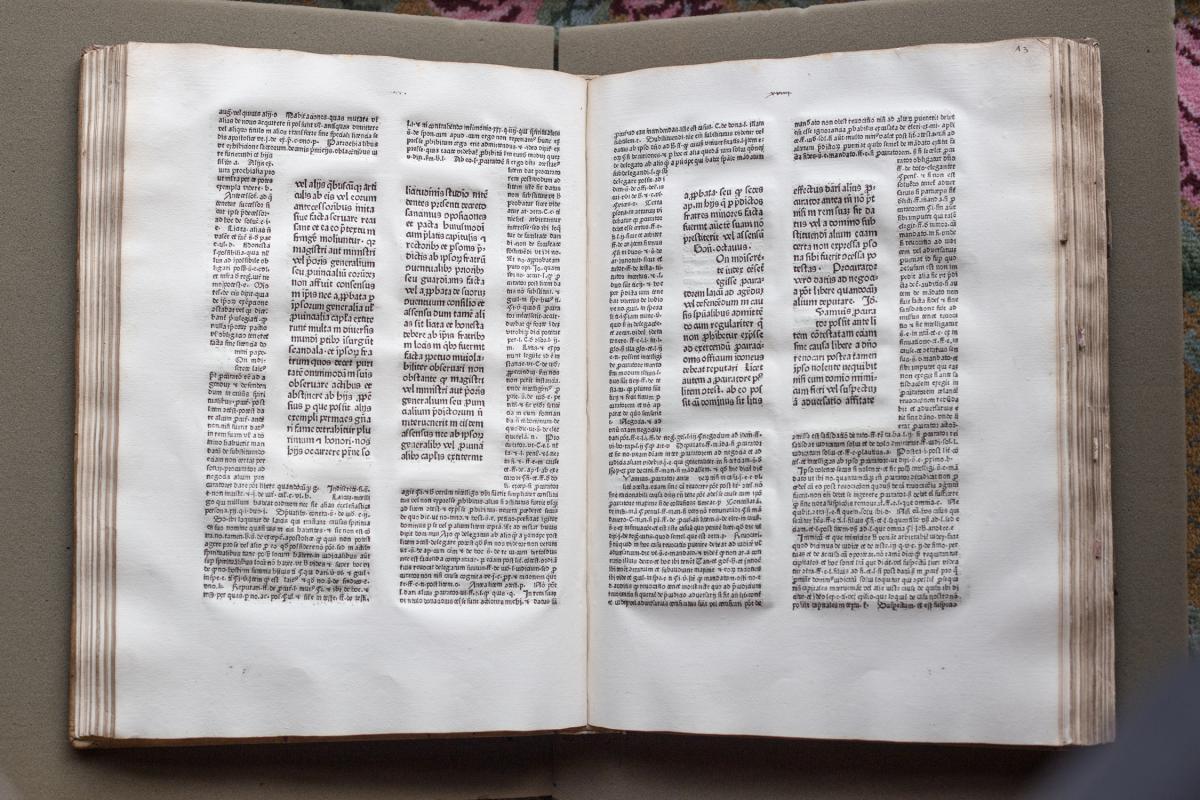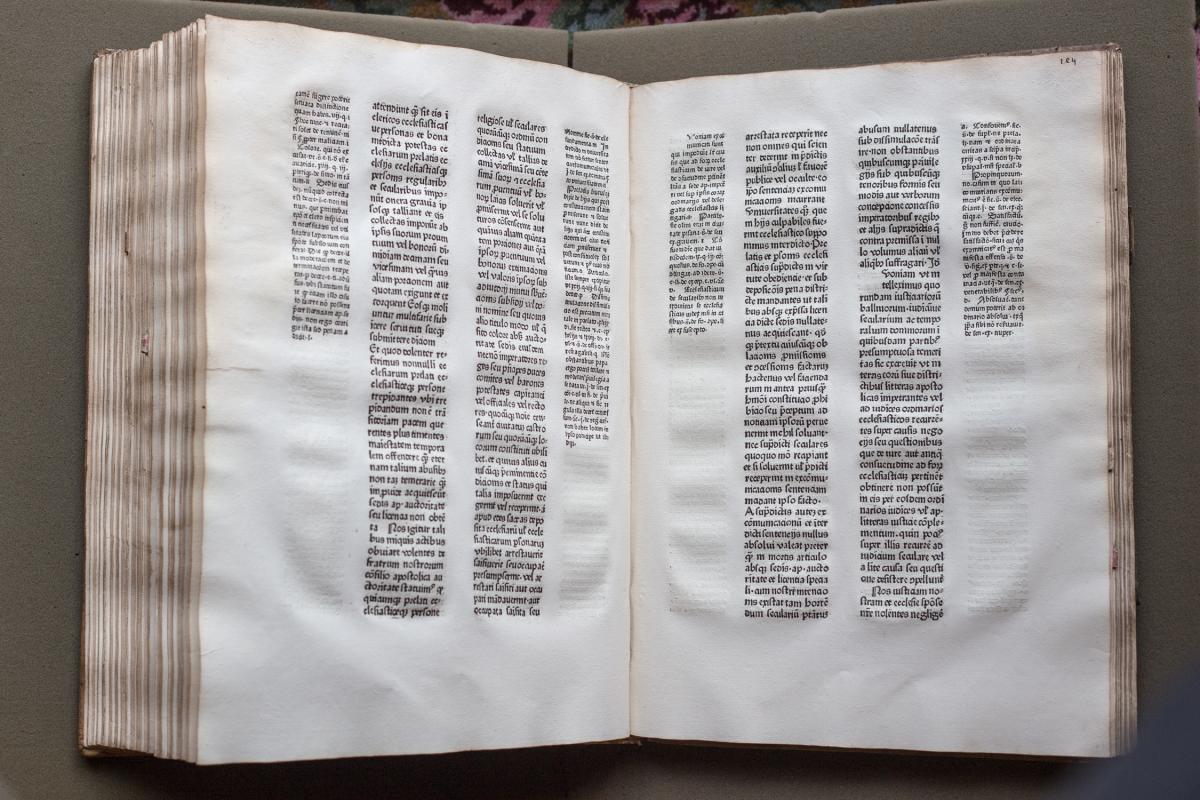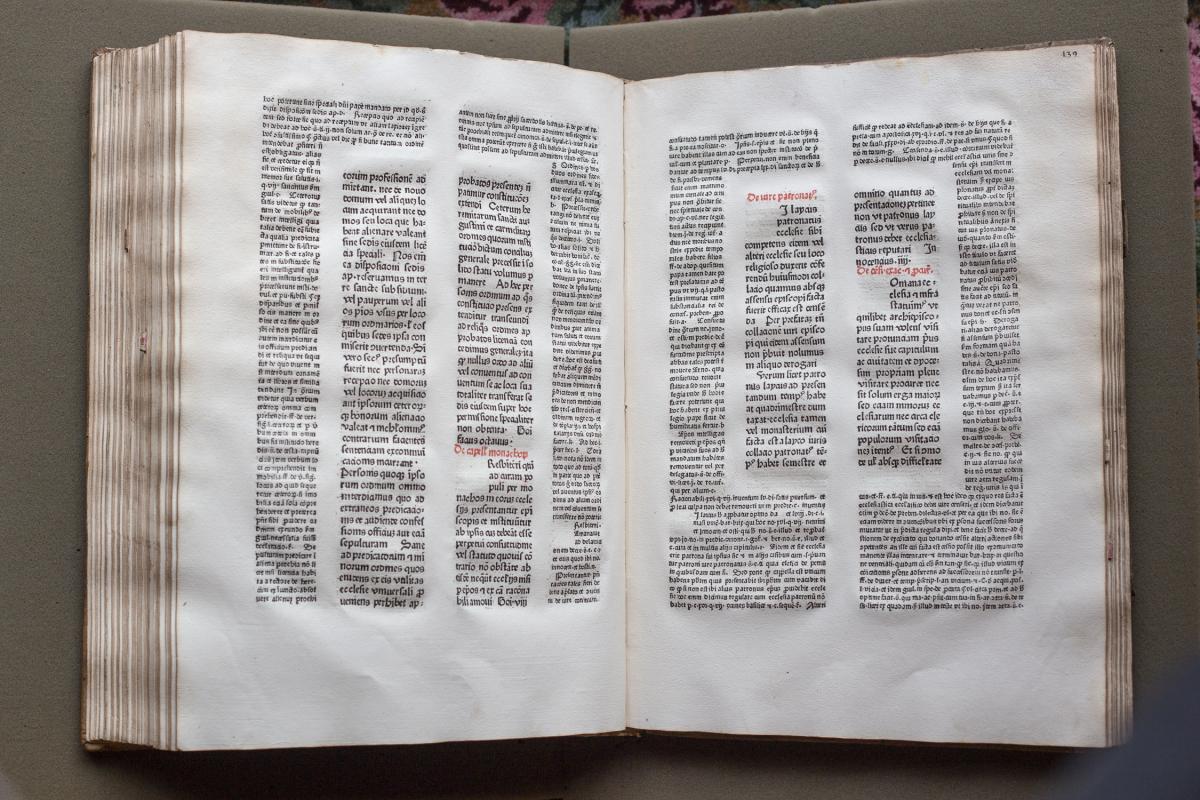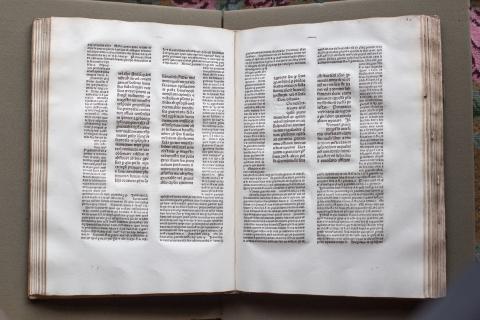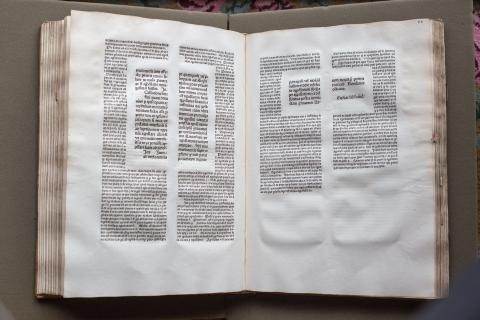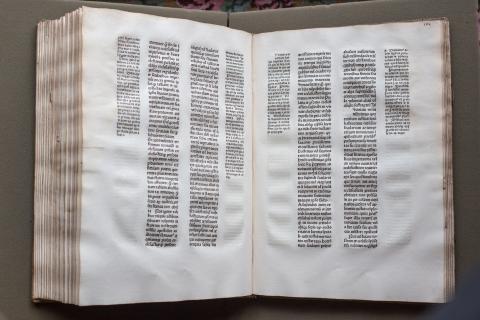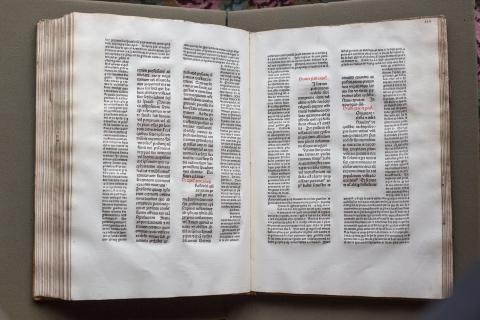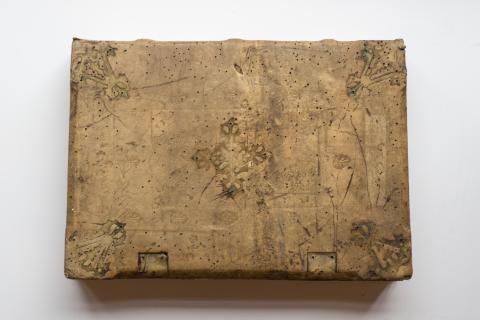Liber Sextus Decretalium with Gloss from Johannes Andreae
Liber Sextus Decretalium with Gloss from Johannes Andreae
German, ca. 1473
Compiled by Boniface VIII, Pope (Italian pope, born ca.1235-1240, died 1303)
height 29 cm
width 41.3 cm
Multnomah County Library Catalog Number: W093 Asc. No. 5882 - 31168045415286
Justin Reeves, Medieval Portland Capstone Student, Summer 2014
The Liber Sextus Decretalium is a fifteenth-century book containing the collection of decretals, papal decisions on Catholic law, compiled by Pope Boniface VIII. They are collectively known as the Liber Sextus Decretalium. The book also contains a gloss from Johannes Andreae. Pope Boniface's Liber Sextus Decretalium is a continuation of the Decretals of Pope Gregory IX, thus it was named Liber Sextus (Book Six)[1].
The author of the gloss, Johannes Andreae, one of the first glossators of decretals, was a contemporary of Boniface VIII and an expert in canon law known for his extensive commentaries on papal decretals. Andreae was one of the first individuals to write gloss for decretals. The edition was printed in the year 1473 in Strasbourg by printer Heinrich Eggestein. The spine of the book lists a date of 1468. The entirety of the handwritten text on the spine reads: "Bonifacius VIII Papa, 1468," printed in Gothic letter script. This text on the spine is from a later period from the printing of the book and its binding. The 1473 date is, with some degree of certainty, the most likely date. Based upon misaligned text on the first page identically matching the corresponding text in a copy of the book located in Dusseldorf, the two books can be dated from the same print run. The date of 1473 came from dating the paper of a copy located in Freiburg by someone referred to as "Sack" [2].
Henrich Eggestein was one of the first known printers in Europe. He worked out of Strasbourg, an imperial city of the Holy Roman Empire at the time, Eggestein was born in Rosheim, which is in the Alsace region in modern-day France, and moved to Strasbourg in the early 1440s[3]. Eggestein worked as a printer between the years of 1464 and 1488, starting shortly after Johannes Mentelin, another Strasbourg printer[4]. Eggestein is considered one of the earliest printers in Europe outside of Mainz, where Gutenberg created the first press.
This book is printed in Latin on paper instead of vellum, which was common at the time, and has a contemporary leather binding with numerous wormholes through the boards. The boards are approximately 29 centimeters wide and 41.3 centimeters tall. The pages are fairly well preserved but have some water damage in parts. The leather cover on the board has marks, where metal adornments were previously attached, as well as clasps. The metal pieces are no longer with the book. The inside of the front and back covers also have imprinted text from pages no longer within the book. This text may have been glued to the insides of the boards and is in Latin as well. It is in varying sizes, and as it does not appear to be in the same format as the bulk of the text, it is likely unrelated. Some of the pages have what appear to be chapter or section markers sticking out of the edge of the page. There is only a handful of these. The markers could be for the separate books of the Decretalium. The book does not appear to be as the large rubrication only appears in the first few pages of the book. The rest of the book contains empty indents where such rubrication would have been completed. There is also text at the beginning of the book that seems to be the name of a monastery, possibly an indication of original ownership.
The book was given to the Multnomah County Library by John Wilson, who left dealer notes in front of the book. These notes contain mention of a sale in New York in the year 1891 by Dodd, Mead, and Company, but these notes seem to indicate the sale of a different edition of the book, printed on vellum by Fust and Schoeffer (early contemporaries of Eggestein [5]) in 1465. There is an indication in the notes at the beginning of the book of an alternate edition from 1473 printed partly on vellum, and partly on paper which was sold at Mt. Gaignat's sale in 1769, but there is no indication of how it relates to this copy. John Wilson acquired this particular copy of the Liber Sextus Decretalium from Mr. B.F. Stevens - a book dealer from London - around the year 1890. In a letter dated November 14th, 1890 from Mr. Stevens to Mr. Wilson, he mentions the acquisition of the Liber Sextus Decretalium, undoubtedly the copy now housed in the Multnomah County Library.
The Liber Sextus Decretalium of Pope Boniface VIII housed at the Multnomah Country Library's Wilson Rare Book Room is a good example of the type of works that were printed by early European printers like Heinrich Eggestein. Despite metal adornments missing from the leather cover on the front board and some water damage, the book is in good condition. Heinrich Eggestein was not the first or the most skilled printer of this time, but this work provides a wonderful example of the earliest books in Europe.
NOTES:
[1] A. Van Hove, "Liber Sextus Decretalium." The Original Catholic Encyclopedia. http://oce.catholic.com/index.php?title=Liber_Sextus_Decretalium.
[2] "Record Details: Liber Sextus Decretalium. Comm: Johannes Andreae." Incunabula Short Title Catalogue. http://istc.bl.uk/search/search.html?operation=record&rsid=111728&q=2
[3] Wikimedia Foundation. "Heinrich Eggestein." Wikipedia. http://en.wikipedia.org/wiki/Heinrich_Eggestein
[4] S. H. Steinberg, and John Trevitt. Five hundred years of printing. New ed. London: British Library, 1996, 20.
[5] Steinburg, 26-27.
Bibliography
Buringh, Eltjo , and Jan Luiten Van Zanden. "Charting the 'Rise of the West': Manuscripts and Printed Book in Europe, a Long-Term Perspective from the Sixth through Eighteenth Centuries." The Journal of Economic History 69, no. 2 (2009): 409-445.
Clark, Harry. "Four Pieces in a Press": Gutenberg's Activities in Strasbourg." The Library Quarterly: Information, Community, Policy 49, no. 3 (1979): 303-309.
Glaister, Geoffrey Ashall. Encyclopedia of the Book. 2nd ed. New Castle: Oak Knoll Press, 1996.
Haraszti, Zoltán. "Medieval Manuscripts." The Catholic Historical Review 14, no. 2 (1928): 237-247.
Van Hove, A. "Liber Sextus Decretalium." The Original Catholic Encyclopedia. http://oce.catholic.com/index.php?title=Liber_Sextus_Decretalium (accessed August 5, 2014).
Van Hove, A. "Papal Decretals." The Original Catholic Encyclopedia. http://oce.catholic.com/index.php?title=Papal_Decretals (accessed August 5, 2014).
Jeffery, Peter. "Notre Dame Polyphony in the Library of Pope Boniface VIII." Journal of the American Musicological Society 32, no. 1 (1979): 118-124.
Needham, Paul. "A GUTENBERG BIBLE USED AS PRINTER'S COPY BY HEINRICH EGGESTEIN IN STRASSBURG, CA. 1469." Transactions of the Cambridge Bibliographical Society 9, no. 1 (1986): 36-75.
"Pope Boniface VIII." CATHOLIC ENCYCLOPEDIA. http://www.newadvent.org/cathen/02662a.htm (accessed July 14, 2014).
Putnam, George Haven. Books and Their Makers During the Middle Ages. New York: Hillary House Publishers LTD., 1962.
"Record Details: Liber Sextus Decretalium. Comm: Johannes Andreae." Incunabula Short Title Catalogue. http://istc.bl.uk/search/search.html?operation=record&rsid=111728&q=2 (accessed August 2, 2014).
Steinberg, S. H., and John Trevitt. Five hundred years of printing. New ed. London: British Library, 1996.
Wikimedia Foundation. "Giovanni d'Andrea." Wikipedia. http://en.wikipedia.org/wiki/Giovanni_d'Andrea (accessed August 2, 2014).
Wikimedia Foundation. "Heinrich Eggestein." Wikipedia. http://en.wikipedia.org/wiki/Heinrich_Eggestein (accessed August 2, 2014).

